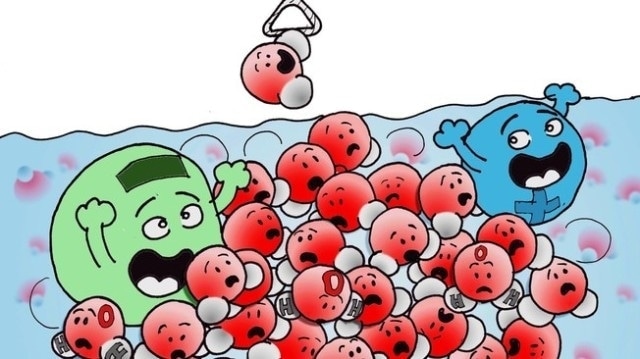Apr 12 2016
Water is considered to be both complex and simple at the same time. Only 3 atoms make up a single water molecule (H2O). Despite this fact, the behavior of water molecules is still considered to be unique.
 A single ion has an influence on millions of water molecules, i.e. 10,000 times more than previously thought. Credit:LPB/EPFL
A single ion has an influence on millions of water molecules, i.e. 10,000 times more than previously thought. Credit:LPB/EPFL
Water molecules are connected to each other by hydrogen bonds, which disintegrate and form billions of times per second. It is because of these bonds that water has unusual and unique properties. Living organisms are made up of 60% of salty water, therefore interpreting the interactions between ions and water plays a vital role to understand life.
Not 100 but 1,000,000 molecules are influenced
Sylvie Roke headed a team of researchers from EPFL's Laboratory for fundamental BioPhotonics to analyze the impact of ions on the water structure with extraordinary sensitive measurements. From their multi-scale analysis, they discovered that a single ion influences a countless number of water molecules. The journal, Science Advances, features an article in which the researchers describe how one individual ion is capable of twisting the bonds of millions of water molecules, covering a distance of more than 20 nm, causing a stiffening of the liquid.
Until now it was not possible to see ions influence more than a hundred molecules (a distance of around 1 nm). Our measurements show that water is much more responsive to ions than we thought.
Sylvie Roke, Laboratory for Fundamental BioPhotonics, EPFL
Water molecules line up around the ions
Two positively charged hydrogen atoms and one negatively charged oxygen atom make up the water molecules. The center of the "Mickey Mouse-shaped" molecule does not contain the same charge as its extremities. When an ion comes in touches water, it leads to perturbation of the network of hydrogen bonds. This perturbation travels across millions of other molecules, and results in an orderly arrangement of water molecules in a particular direction. This arrangement could also be referred to as stiffing of the network of water molecules between different ions.
From atomistic to macroscopic length scales
Three approaches were used to test the behavior of water. They include a computer simulation on the atomic scale; ultrafast optical measurements exhibiting how the molecules are arranged on the nanometric scale; and measurement of the water’s tension and surface structure carried out at the macroscopic level.
For the last method, we simply dipped a thin metal plate into the water and pulled gently using a tensiometer to determine the water's resistance to pulling. We observed that the presence of a few ions makes it easier to pull the plate out, that is, ions reduce the surface resistance of water. This strange effect had already been observed in 1941, but it remained controversial and unexplained until now. Through our multi-scale analysis we were able to link it to ion-induced stiffening of the bulk hydrogen bond network: a stiffer bulk results in a comparatively more flexible surface.
Sylvie Roke, Laboratory for Fundamental BioPhotonics, EPFL
Testing different salts and different "waters"
The same experiment was repeated with 21 varieties of salt, and all of the salts affected the water in similar ways. The researchers then analyzed the impact of ions on heavy water (D2O), whose hydrogen atoms are isotopes, which are heavy because the nucleus contains an additional neutron. This liquid is found to be nearly indistinguishable from regular water, but the properties in this case are extremely different. Ion concentration that is six times higher will lead to perturbation of the heavy water in the same manner. This provides more proof about the uniqueness of water.
No link with water memory or homeopathy
Roke and her team of researchers are aware of the possibility of connecting these results to a variety of complex beliefs about water. However, they are cautious enough to distance themselves from any further interpretation.
Our research has nothing to do with water memory or homeopathy. We collect scientific data, which are all verifiable. "To prove the role of water in homeopathy, another million-billion-billion water molecules would have to be affected to even come close, and even then we are not certain.
Sylvie Roke, Laboratory for Fundamental BioPhotonics, EPFL
The recent discovery on the behavior of water will find suitable applications in fundamental research and other related areas. The interaction between ions and water is common in biological processes related to protein folding, ion channels, and enzymes. An insight into how life works is provided by every new bit of knowledge.